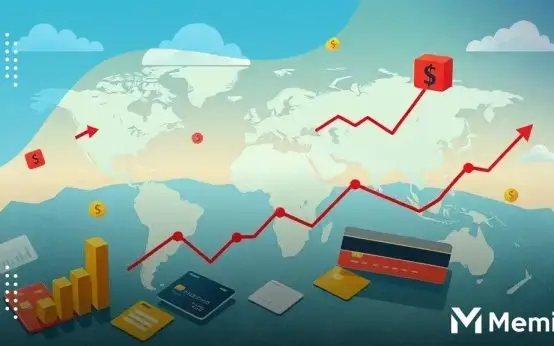
It’s not a great time to be a saver or a borrower as financial markets face unprecedented challenges. High interest rates burden borrowers and impact savers’ returns. This dual predicament leaves individuals seeking strategies to mitigate risks. Exploring current challenges for savers and borrowers can illuminate paths for financial resilience. With a clear understanding of the economic landscape, it becomes vital to adapt and prepare for future uncertainties. Let’s dive into effective strategies and understand the broader economic picture.
Current Challenges for Savers
Rising Inflation is one of the major challenges for savers today. With costs increasing, the purchasing power of money declines, meaning the money saved today might buy less in the future. This erosion of value can deter people from saving as diligently as they might in a stable economic environment.
Additionally, low-interest rates contribute to the difficulties faced by savings account holders. While low-interest rates make borrowing cheaper, they also result in lower returns on savings. This trend makes it harder for individuals to grow their savings over time without exposing them to higher risks in the stock market or other investment vehicles.
The volatility of the global economy means geopolitical events can have immediate effects on currency value and economic stability. Savers might feel the pinch as exchange rates fluctuate, affecting their savings’ true value on an international scale.
Lastly, there’s an increasing need for financial literacy. Knowledgeable savers can better navigate these financial waters, but without adequate resources or understanding, individuals may struggle to make informed decisions, exacerbating these challenges.
The Impact on Borrowers

The repercussions for borrowers during these times are substantial. Individuals have encountered increased interest rates, making it more expensive to secure loans or mortgages. This can exacerbate the financial strain on families aiming for homeownership or those needing personal loans for emergencies.
Borrowers may also see changes in their creditworthiness, impacting their ability to access funds. Lenders have tightened criteria, prioritizing borrowers with higher credit scores, effectively excluding those with perceived higher risks.
Furthermore, with economic uncertainties, many face the risk of variable rate loans adjusting unfavorably. Increased rates can lead to higher monthly payments, squeezing disposable income further. This scenario forces borrowers to reevaluate financial strategies, possibly extending loan terms or consolidating debt to manage expenses better.
Moreover, students relying on loans for education face similar difficulties. Elevated rates add to the already burdensome student debt, demanding greater scrutiny and strategic planning. As a result, borrowers are not only navigating current financial hurdles but are also planning around potential future shifts, seeking stability in a volatile market.
Strategies to Navigate Financial Hurdles
Amidst an evolving financial landscape, knowing how to maneuver through tough times can make a difference. The key is to develop a financial plan that accommodates sudden changes and financial strain. Start by assessing your current situation. Calculate your total debt, available savings, and monthly expenditures. This helps in understanding what adjustments are necessary.
Next, consider revising your budget. Identify non-essential expenses that can be reduced or eliminated. The aim is to strike a balance that sustains your needs while preparing for unexpected events or emergencies.
Exploring alternative income streams can provide additional support. Think about freelancing, part-time work, or leveraging skills for consulting. Diversifying your income sources reduces reliance on a single source and provides a safety net.
Communicate with creditors
if you’re struggling with debt repayments. Many institutions offer flexible payment plans or temporary relief options. Proactively manage these relationships to avoid long-term consequences.
Equipping oneself with financial literacy is a powerful tool. Engage with workshops, online courses, and financial advice columns. Staying informed helps in making sound decisions and anticipating market trends.
Lastly, consider emergency savings if feasible. Even small contributions matter over time, gearing you for unforeseen financial demands. Strategic planning and informed decisions can significantly aid in navigating financial hurdles effectively.
Future Outlook and Economic Predictions

Economic Predictions
The future of the economy presents both challenges and opportunities. Analysts predict that interest rates might fluctuate in the coming years due to global economic tensions and changing fiscal policies. Savings could earn better returns once rates stabilize, but market volatility remains a concern. Economic growth is expected to recover post-pandemic, but structural adjustments may lead to uncertain conditions.
Future Outlook
The economic outlook suggests that individuals need to stay informed and adaptable. Inflation could impact purchasing power significantly, adding another layer of complexity for savers and borrowers alike. Policymakers may need to implement new measures to sustain growth without causing further imbalance. Keeping a close eye on economic indicators and preparing for various scenarios could be crucial steps for both individuals and businesses aiming to thrive in this unpredictable environment.


 Navigating the Higher Education Finance Maze <p class='sec-title' style='line-height: normal; font-weight: normal;font-size: 16px !important; text-align: left;margin-top: 8px;margin-bottom: 0px !important;'> Understanding the essentials of education finance is crucial when delving into the intricate maze of higher education financing </p>
Navigating the Higher Education Finance Maze <p class='sec-title' style='line-height: normal; font-weight: normal;font-size: 16px !important; text-align: left;margin-top: 8px;margin-bottom: 0px !important;'> Understanding the essentials of education finance is crucial when delving into the intricate maze of higher education financing </p>  The Great Debate: To Buy a House or Keep Renting? <p class='sec-title' style='line-height: normal; font-weight: normal;font-size: 16px !important; text-align: left;margin-top: 8px;margin-bottom: 0px !important;'> The Great Debate stands as a pivotal discussion in modern times, drawing attention from scholars and enthusiasts alike </p>
The Great Debate: To Buy a House or Keep Renting? <p class='sec-title' style='line-height: normal; font-weight: normal;font-size: 16px !important; text-align: left;margin-top: 8px;margin-bottom: 0px !important;'> The Great Debate stands as a pivotal discussion in modern times, drawing attention from scholars and enthusiasts alike </p>  The American Credit System: Your Best Friend (or Worst Enemy) <p class='sec-title' style='line-height: normal; font-weight: normal;font-size: 16px !important; text-align: left;margin-top: 8px;margin-bottom: 0px !important;'> The American Credit System plays a pivotal role in shaping financial opportunities </p>
The American Credit System: Your Best Friend (or Worst Enemy) <p class='sec-title' style='line-height: normal; font-weight: normal;font-size: 16px !important; text-align: left;margin-top: 8px;margin-bottom: 0px !important;'> The American Credit System plays a pivotal role in shaping financial opportunities </p>